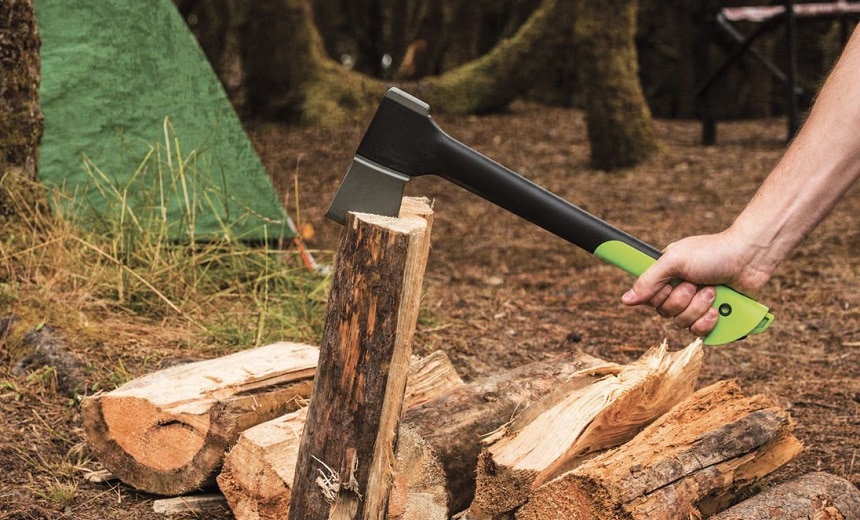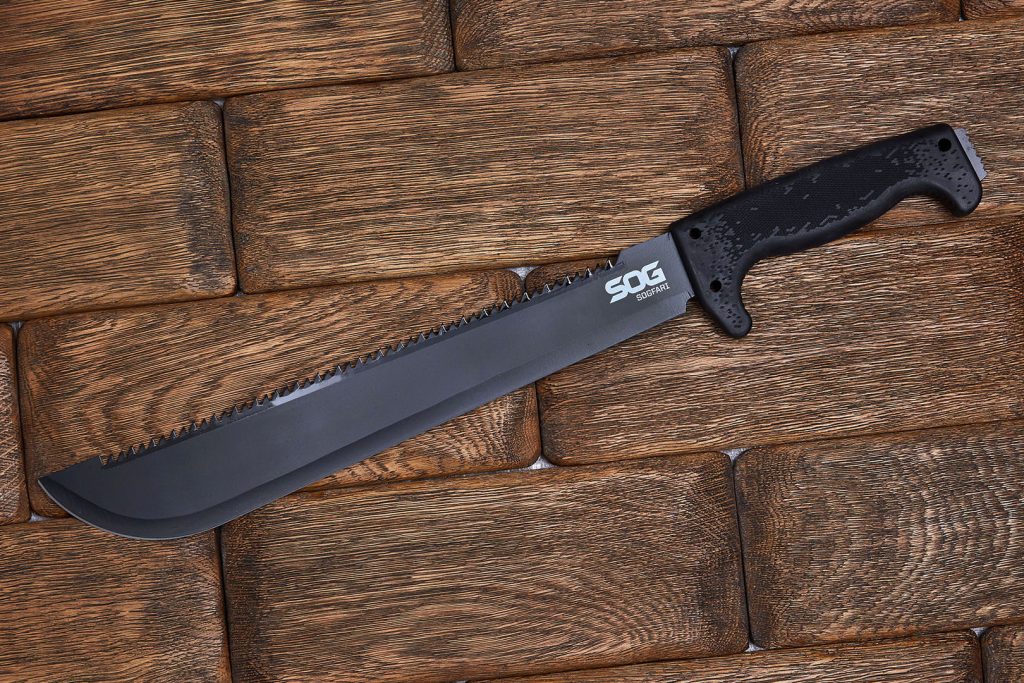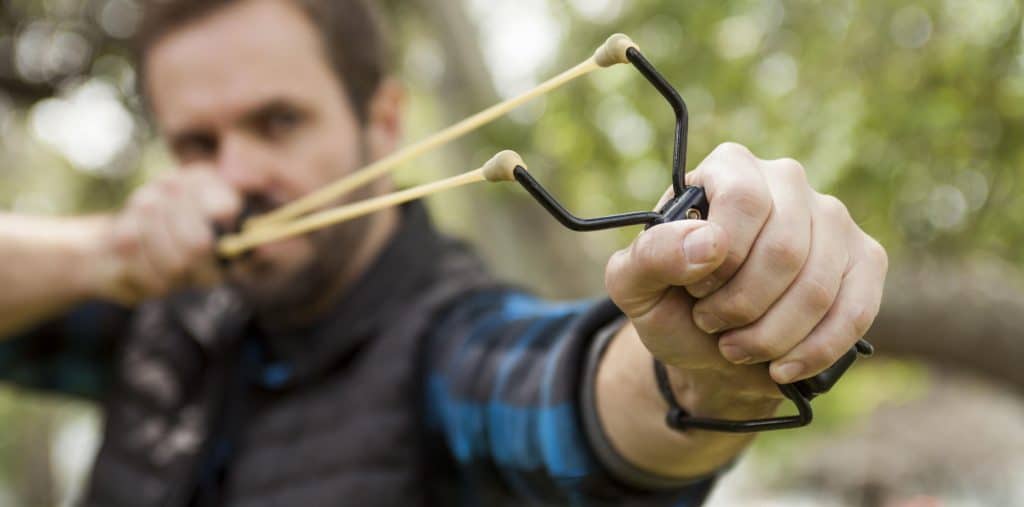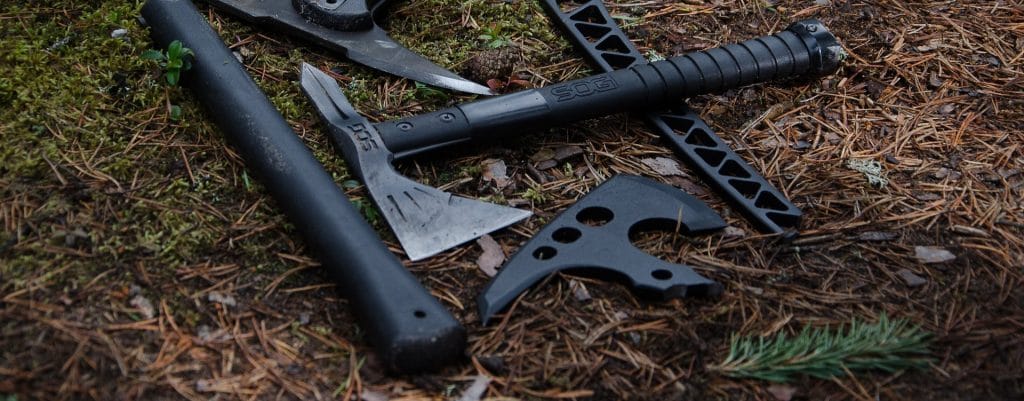

If you’re putting together a camping or survival kit, you’ve probably already included a knife. But don’t forget about the tomahawk – the knife’s bigger and more multi-purpose brother. The best tomahawk is much more than just a cutting tool. You can use it as an axe for chopping wood or breaking down barriers, as a powerful self-defense weapon, or even as a hunting tool.
In order to help you find the right tomahawk to add to your survival gear or bug out bag, we looked at a number of features that affect the performance and usability of these tools. To start, we considered the material of the blade, which directly affects the cutting power, weight, and overall durability of a tomahawk. We also looked at the grip material, which determines how comfortable the hatchet will be when you’re using it for hours of chopping wood. Size and weight were also important factors since the chances are high that you’ll be carrying your tomahawk deep into the backcountry at some point.
We spent tens of hours researching tomahawks by poring over technical specifications and reading hundreds of user reviews. The result is our list of the ten best tomahawks on the market today, highlighted in the table below. Continue reading for detailed reviews of each tomahawk, complete with pros and cons. Our buying guide covers everything you need to know about choosing the perfect axe for your kit. Finally, we sum up our three overall favorite tomahawks for any survivalist and backcountry enthusiast.
This lightweight tactical tomahawk is one of our favorites for its versatility and low cost. The tomahawk features a square stainless-steel blade that’s as good for chopping as it is for hand-to-hand combat. But to look only at the blade distracts from the greater utility of this tool. The vertical adze on the rear end of the blade is perfect for digging into the ground, allowing this tomahawk to be used for excavating a shelter or trench. Plus, the flat bottom of the handle can be used for breaking down doors and windows.
The blade and handle are two separate pieces, but that doesn’t take away at all from the balance of the tomahawk. It’s slightly weighted towards the head, with just enough imbalance to aid with chopping. However, some users found that this does decrease the durability of the axe – the handle can break off after extended use, and SOG doesn’t offer replacement handles.
The grip is made from glass-reinforced nylon, which offers a textured surface for excellent traction. Users felt that this tomahawk is ideal for making fast strikes during combat and can even be used for throwing thanks to the sticky grip. Keep in mind, though, that the light 19-ounce weight means that it will take some mastery to throw it accurately.
SOG includes a nylon case with this tomahawk, although users found that this can fray easily from the blade and wished for a Kevlar sheath.
This slightly elongated tomahawk-axe hybrid from Estwing makes an ideal camping and bushcraft tomahawk. The 14-inch length and large blade head ensure that this tomahawk has some heft towards the head, which offers a significant increase in momentum when chopping. Where tactical tomahawks might struggle to break through tree limbs, this tomahawk can quickly cut through entire branches. That said, don’t expect to use this tomahawk as an agile weapon for close combat – the blade is somewhat the wrong shape, and the curvature of the handle makes it hard to attack an enemy.
One common complaint that outdoor users had with this tomahawk was the handle. While it looks quite pretty, the lacquered leather is slippery in the hands and can dry and chip over time. Because of that, many users immediately sandpapered off the lacquer finish upon receiving the tomahawk to get down to the leather itself. So, expect to put in some work to improve the axe after you get it.
Users appreciated that the steel blade retains its sharpness well over a lifetime of chopping wood. Better yet, the shape of the blade makes it simple to sharpen in the field so you can get back to work. The tomahawk is made in the USA, but you’ll still need to watch out for quality control issues with the blade – some users reported their tomahawk arriving with chips in the steel.
This massive wood-handled tomahawk from CRKT features a unique blade shape that makes it suitable for a wide variety of purposes. First and foremost, the blade is designed for chopping. The axe-like curvature of the bevel can eat through large branches with close to the efficiency of a hatchet – the blade bites well and chops deep with every swing.
Meanwhile, the toothy spike on the underside of the blade gives this tomahawk a scary amount of power during hand-to-hand combat. It may not be the most agile weapon, but if you hold the handle close to the blade, you can use both the axe bevel and the underside spike to your advantage in a fight. Finally, the flat adze on the rear of the blade is ideal for hammering in stakes or for breaking through doors and windows.
The handle is made from Tennessee hickory wood, which users overall liked. However, many found that they needed to sand down the wood to get a more stable grip on the tomahawk. In addition, the two-piece construction means that the head is designed to come off, and it’s only held in place by pressure. While some users never found this to be an issue, some had trouble getting the axe head to remain on the handle during heavy use.
Note that this tomahawk doesn’t come with a sheath, although you can purchase one as an extra. However, the blade does come with a limited lifetime warranty, which is rare among tomahawks.
This relatively short tomahawk from CRKT was designed with multi-purpose tacticians in mind. Everything about this tool was designed to be compact, lightweight, and agile. The blade head is no larger than it needs to be to reach out in front of the handle for effective chopping, and the curvature of the blade gives it an extra surface area for penetrating deep into the wood. The carbon steel blade is sharp and hard enough for shaving metal as well, while the aggressive spike can be used for digging.
The glass-reinforced nylon handle on this tomahawk is one of its most-loved features among users. Not only does it offer exceptional grip, but the multiple protrusions give you places to choke up on the tomahawk for greater control. Users felt that the tomahawk is well balanced and easy to handle in combat situations thanks to its light 1.5-pound weight.
The main issue that users found with this tomahawk is durability. The bottom edge of the blade is particularly prone to chipping when cutting through anything harder than wood – including metal and bone. Likely, this is because of too high a percentage of carbon used in the steel, and there is no way around the issue.
Still, this was something that many users who are looking to use the tomahawk primarily in the backcountry can overlook. The blade comes with a MOLLE-compatible sheath that includes a shoulder strap, and it’s one of the easiest tomahawks to carry deep into the woods. It also comes with a limited lifetime warranty (which does not cover chipping in the blade from use).
This small but weighty tactical tomahawk from SOG is a favorite among combat users, backcountry survivalists, and tomahawk throwers alike. The tomahawk and the upper part of the handle are constructed from a single piece of stainless steel, which makes it extremely durable. The blade is square with a deep underbite that can be helpful for both chopping wood and for aggressive hand-to-hand combat. Plus, unlike some other blades, this shape isn’t as prone to chipping since the blade is crafted from relatively soft stainless steel rather than carbon steel.
The spike on the rear of the blade is one of the features that most sets this tomahawk apart. The spike is heavy-duty enough to be used for serious digging, but it can also be used in combat for piercing. Of course, that means you’ll have a second point to keep sharp – and you’ll need to watch out for it when chopping. A flat bottom to the handle supplements the spike for multi-purpose uses like hammering.
The heft of this tomahawk – it weighs 23 ounces despite being just 12.5 inches in length – makes it one of the best throwing tomahawk we’ve seen. The axe spins relatively slowly in the air, offering better aim and easier practice for beginners. Users loved that the nylon grip offers certainty that your hand won’t slip when holding this tomahawk. Plus, the underbite of the blade can be quite handy in sticking the blade into its intended target. Just keep in mind that throwing this tomahawk will reduce its lifespan – users found that the handle can eventually break off when using it as a throwing axe.
This tomahawk from Gerber is expensive, but if you’re looking specifically for a military-grade combat weapon, there is no choice better. To start, this tomahawk is a massive 19.3 inches long, which provides plenty of space between you and your enemy to keep you out of harm’s way. The high-carbon steel blade is tough enough to cut through flesh and bone – as well as wood and metal – without breaking or bending.
Keep in mind, though, that this tomahawk was made for swinging rather than fast and light cuts. At almost two pounds, it can be heavy to carry around and difficult to move quickly. In addition, users reported that the blade edge is very dull and takes quite a bit of work to sharpen.
One of the unique design aspects of this tomahawk that makes it perfect for military and police use is that the bottom of the handle doubles as a pry bar. You can put your hand through the contoured hole in the blade head to put pressure on the pry bar. But, this design comes at a high cost of balance. The bottom of the handle is the heaviest part of this tomahawk, which makes chopping and combat motions relatively difficult.
Users were happy with the unique G-10 grip material on this tomahawk, which is grippy without requiring additional custom work to ensure it holds traction. It’s also worth noting that this tomahawk comes with a MOLLE-compatible sheath, which gives you a wide range of options for attaching it to your body armor or backpack.
Users love this compact tomahawk from Browning, which can be used as well in the backcountry as it can be in tactical situations. The entire tomahawk is constructed from a single piece of high-carbon 1055 steel, ensuring that it’s virtually impossible to break, bend, or chip the tool. The blade shape is relatively ideal for chopping, without being too large for precision uses like skinning game or combat. In addition, backcountry users liked the sharp adze on the rear of the blade, which could be used as a hook as well as for piercing. However, keep in mind that there is no flat area to use as a hammer on this tomahawk.
Another aspect that makes this tomahawk suitable for a wide variety of situations is the nylon paracord grip. The paracord can be removed and used on its own when needed, but otherwise provides unparalleled traction for the tomahawk.
The main concern that tactical users had with this tomahawk is its weight. At two pounds, this tomahawk is surprisingly hefty. While that adds momentum to every swing of the tool, it also takes away agility and makes it more cumbersome to carry the tomahawk deep into the backcountry.
The MOLLE-compatible sheath is a welcome addition to this capable tomahawk that further improves its standing as a tactical weapon. Weight notwithstanding, it’s easy to carry this tool in a wide variety of configurations, and the sheath won’t wear down over time.
This simple tomahawk from SOG shares a lot of commonalities with hatchets, which makes it a great tool for survival. Perhaps the greatest advantage of this tomahawk is that it’s just one pound – it’s the lightest tomahawk we’ve reviewed. That means that you’ll never be tempted to leave it at home when heading deep into the backcountry.
When you do find yourself in a survival situation, this tomahawk offers an excellent stainless-steel blade for chopping wood and a flat adze for use as a hammering surface. The lightweight of the tomahawk does reduce t’s blade’s momentum with each swing, so you may have to work to chop through thicker branches with this tool. In fact, the main complaint that users had with this axe was that it’s too small for many non-survival backcountry situations.
That said, there are many other reasons to love this tomahawk. The glass-reinforced nylon handle provides excellent grip, so you never have to worry about having the blade slip out of your hand. Plus, the lightweight nature of this tomahawk means that it can be used as an agile weapon in a combat situation.
SOG does provide a sheath with this tomahawk, but it is somewhat disappointing. The sheath does not offer much coverage area and can be difficult to get onto the blade, so there is a real chance of cutting yourself when trying to cover the blade.
This wood-handled tomahawk features a fun engraving of a wolf on the blade, but don’t let that distract you from the many features this tool has to offer. The stainless steel blade arrives sharp and is easy to keep that way. Plus, users liked that the broad curvature of the blade provides a large surface area for chopping wood. The spiked adze can be used for piercing or as a hook, although you won’t want to use the base of the handle for hammering since it can easily destroy the wood.
The tomahawk is rather heavy for its length at two pounds. Users did not mind the extra weight since this tomahawk is best suited for chopping and the extra heft gives some more momentum to each strike. However, given that the hatchet seems primarily designed for chopping, users would have liked to see the handle extended a few inches to offer more leverage.
The other downside to this tomahawk is that the rosewood handle is not constructed for the level of durability heavy users will need. The handle can become somewhat loose from the metal shank with use, which presents a somewhat dangerous situation when chopping with the tomahawk. Likewise, the wolf pattern on the finish can slowly be erased from the blade as the tomahawk sees extended use.
Note that this tomahawk comes with a nylon sheath, which users found was relatively durable and easily covered the blade for safety.
This inexpensive tomahawk from Schrade is a workhorse for backcountry explorers and survivalists on a tight budget. The blade is constructed from titanium coated stainless steel and features the curvature of an axe for the maximum cutting area. While the blade comes slightly sharp, users found that sharpening it to a razor edge was easy and the stainless steel holds its edge well when cutting through wood.
Keep in mind that this tomahawk is relatively small. It’s under one foot long and weighs just one pound, so you won’t get much leverage or momentum out of your savings. That’s not a problem for most users, but can be troublesome if you are expecting something closer to a hatchet.
The rubber handle, while not as aesthetically pleasing as other handle materials, is actually quite good at offering traction. The rubber has a few contours to help hold your fingers when chopping and there is even room to choke up if you need to use the tomahawk in a combat scenario. Better yet, the rubber handle does have some vibration dampening capabilities that can help if you miss your target when chopping.
Schrade seems to have lowered the price of this tomahawk by skimping on quality control, though. Users report their tomahawks falling apart from many different actions, including trying to use the rear of the blade as a hammer or getting the blade stuck in a piece of wood and pulling up on the handle. So, if you do opt for this tomahawk, be wary of using it in a heavy-duty way.
Now that you’ve learned more about our ten favorite tomahawks, how do you choose the perfect blade for your kit? In our buying guide, we’ll cover everything you need to know about finding the right tomahawk for survival in the backcountry or in an emergency situation.
Tomahawks may be very distinct from knives, but that doesn’t mean all tomahawks are the same. In fact, there are a huge number of differences between tomahawks that are important to know about when deciding on a blade. To help, we’ll take a closer look at the most significant features that differentiate tomahawks and explain how these features can impact their use.
The material of the blade is one of the most important components of any tomahawk. It will determine how well the blade keeps its edge, how easy it is to sharpen, and how it handles cutting through different materials.
The two most common tomahawk blade materials are carbon steel and stainless steel.
When considering a carbon blade, there are different levels of carbon in the blade. To determine the percentage of carbon, look at the last two numbers in the steel description – for example, the 1055 steel in the Browning tomahawk contains 0.55% carbon. Most carbon blades use between 0.50 to 0.60% carbon because it makes for an edge that can easily slice through skin and isn’t as brittle as higher-carbon steel. However, you can also find high carbon steel with 0.70% or higher carbon content that is more suitable for rough tasks like chopping through metal.
Stainless steel blades, like those found on the CoolPlus and SOG tomahawks, are also popular because of their corrosion-resistant properties. However, stainless steel can be somewhat soft compared to carbon-hardened steel, so these blades are better suited for self-defense and wood chopping than cutting through metal. Stainless steel is also generally less expensive than carbon steel, which can be good if you’re looking for a budget tomahawk.
The handle of tomahawks can be made from a variety of materials, including wood, metal, rubber, and nylon.
Wood-handled tomahawks like those from CoolPlus and CRKT are relatively inexpensive. Because the wood handle is a separate piece from the metal blade, it can easily be replaced if the handle breaks. Wood can be somewhat hard to grip, so many users prefer to wrap the wood with grip tape or another material to improve traction.
Tomahawks with metal handles are constructed from a single piece of metal in many cases. That means that the blade and handle are the same pieces of material – you’ll find this construction on the Browning, SOG, and Estwing tomahawks. This makes the tomahawk heavier, but often better balanced, as well as more able to handle the shock of a strike. However, since metal is somewhat hard to grip, it’s common for manufacturers to wrap textured nylon around the handle. Some tomahawks, like the one from Browning, are wrapped with nylon paracord for grip, and the paracord can be used as a survival tool on its own in an emergency.
Tomahawks are generally meant to be relatively short in length – around the size of a hatchet. This short design makes it easier to wield them with accuracy and to use them for detailed tasks like skinning game, chopping small pieces of wood, and hand-to-hand combat. The majority of tomahawks are around 12 inches in length because of this.
However, there are tomahawks up to 19 inches long, like those from Gerber and CRKT. These longer tomahawks offer more leverage, so you can bring the blade down with more force. That’s ideal if you plan to use the tomahawk in a chopping motion, although it can be less wieldy for self-defense – not to mention harder to carry on the outside of a backpack.
Most situations that call for a tomahawk occur in the backcountry so you’ll be hiking potentially for many days with your tomahawk. That means that weight is a priority – you need a tomahawk that not only offers enough power and durability for your purposes but does so without adding any extraneous weight.
Most tomahawks are between one and two pounds, but that range means that the heaviest tomahawks are almost twice as heavy as the lightest models. One-pound tomahawks like the Schrade and SOG tools save weight by being short in length and offering relatively compact blades. Wooden tomahawks like those from CoolPlus and CRKT tend to be heavier, as do tomahawks with relatively long handles.
Keep in mind that the balance of weight in your tomahawk is also important. If the head is significantly heavier than the handle, it will be hard to wield your tomahawk accurately and to use it for hand-to-hand combat. Ideally, the tomahawk should feel solid in your hand, shouldn’t tip forward towards the blade when held loosely.
The price of tomahawks can vary widely based on the construction materials for the blade and handle. It’s easy to find a tomahawk for under $50 – for example, our Editor’s Choice, the SOG tomahawk, costs just $30 and our most budget-friendly option, the Schrade tomahawk, costs about the same. On the other hand, high-end tomahawks can be expensive. The Gerber tomahawk costs around $180.
Our three overall favorite tomahawks on the market today are the SOG Tactical Tomahawk, the Estwing Sportsman’s Axe, and the CRKT Woods Chogan T-Hawk Tomahawk. The CRKT tomahawk stands out for its hefty 2.1-pound weight and 19-inch length. This tomahawk is uniquely simple and uniquely well-suited for chopping through thick branches with an efficiency that rivals hatchets and axes. The Estwing tomahawk is a fine, sharp stainless-steel blade that excels at a variety of uses. The 14-inch long handle offers plenty of leverage for chopping, while the basic-looking design hides how well the tomahawk has been designed for multi-purpose use. We feel that the SOG tomahawk is the overall best tomahawk for the majority of survivalists, tacticians, and backcountry enthusiasts. That’s because it offers a well-balanced and lightweight design, a sharp stainless-steel blade, and a sharpened adze that can be used for digging and piercing to help you adapt to any situation.





